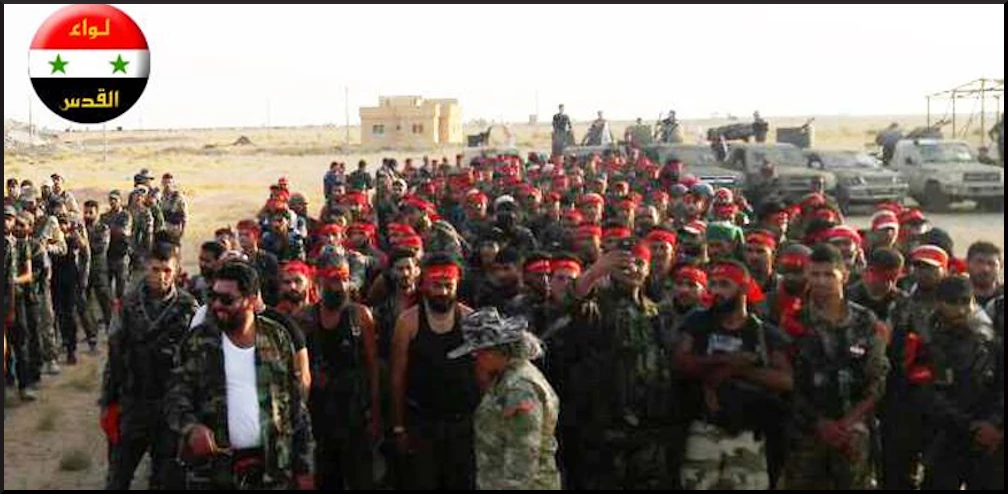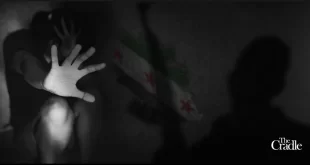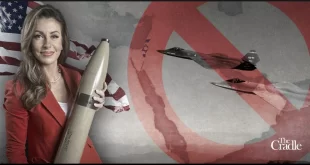by Amal Wahdan of Ramallah, published on Counter-Hegemonic Studies, October 11, 2022
During the last aggression on Gaza, of May 2021 President Bashar Al Assad called the Palestinian factions to a meeting to discuss the “The Jerusalem Sword” military operation, its lessons and ramifications. He praised the role of the Palestinian resistance groups, including the “Izzeddin Alqassam Brigades”, the military arm of the Islamic Resistance Movement (Hamas).
Many observers interpreted this as a good sign in terms of restoring the Syrian relations with Hamas which immensely deteriorated in the aftermath of the global terrorist war on Syria and the formal departure of Hamas leadership from Damascus to Qatar, who spearheaded and sponsored terrorist groups in Syria financially, military, and logistically.
According to Palestinian and Syrian sources, the deterioration of bilateral relations between the Syrian state and Hamas originated from the movement’s support to the so-called “Syrian revolution” and the Free Syrian Army (FSA), an affiliation of the Muslim Brotherhood. Hamas members actively participated in hostile attacks against both Syrian and Palestinian people and civil facilities and institutions of the Syrian state and its people, including the destruction of Yarmouk Refugee Camp, the largest refugee camp outside Palestine.
I have visited Syria several times during the decade-long global aggression proxy war led by the US-NATO countries and their allies in the region but I never had the chance to visit Yarmouk refugee camp, which is known as the capital of the Palestinian refugees in the Diaspora.
The Yarmouk refugee camp, is located few kilometers south of Damascus. It is the largest among twelve refugee camps in six Syrian provinces with 160 thousand Palestinians out of 570 thousands total who took refuge in Syria after the 1948 Nakba. Only 18 thousand people remained in the camp after its occupation on December 12, 2012 by FSA. Then, in 2014 it was invaded by Jabhat Al Nusra, and ISIS until its liberation by the Arab Syrian Army (SAA) and its Palestinian faction’s allies.
The invasion of Yarmouk refugee camp by the terrorist groups was considered to be another Nakba for its Palestinian residents, who like most Syrian people, suffered from the miseries of the terrorist war, i.e. mortar shelling, massive destruction of housing building, infrastructure, displacement, and living in shelters provided by the United Nations for Relief and Work Agency (UNRWA) in different schools and by the Syrian government. The war left behind thousands of deaths and injured civilians.
During my first visit to Syria on January of 2013, I met some Palestinian families and UN school teachers from Yarmouk refugees in Mazzeh UN school shelter. I heard their horrifying stories of the invasion and displacement from their homes in the camp at the hands of the terrorist gangs, whom they believe were supported by the US and its regional allies. They expressed their aspirations to go back to Yarmouk until they return to their Homeland in Palestine.
It took the SAA and its Palestinian allies six years to liberate Yarmouk from the terrorist gangs. On April 2018 when the Syrian government finally reached an agreement to disarm, evacuate and transfer the terrorist groups to Idlib, northwest Syria. Today, the camp is still undergoing gradual rebuilding process. Palestinians think it will take some years to rebuild the camp again and make it inhabitable so that those who fled outside the country can come back to the camp.
During my last trip to Damascus on May 22, 2021 along with an international delegation organized by the Syria Solidarity Movement and Arab Americans for Syria to witness the presidential elections we were actually able to get an official permission to enter the Feda’een neighborhood in Yarmouk refugee camp which is currently undergoing reconstruction, and were able to meet Palestinians who were able to return to the camp after years of ISIS occupation
A Long Road to Damascus
The road to Damascus from occupied Palestine can be very much complicated for some, beyond any expectations. For me, it is just like a minefield while I manage to pass one I start to wonder if it would be possible to detonate the next.
The first minefield is the “Israeli” fortified military border crossing at the Allenby Bridge on the Jordan river which is known of its highest security measures after Lod international airport (Ben Gorion) but very similar to that of Beit Hanaoun military crossing at the northern entrance to Gaza Strip.
Travelers can notice the excavation work on both sides of the road all the way from the first military check post to Allenby Bridge military crossings and at the area surrounding it. This indicates that new policies and arrangements are undergoing for bilateral relations and export-import transactions with the Jordanian side and future trade with the Gulf States. I could not but to take some photos discretely!
From my previous experience I know that my waiting time at the Allenby military check post can take from one hour up to three hours, this is if they do not ban me from traveling. If there is security order to prevent me from traveling it usually takes half an hour maximum. I handed my Palestinian passport to the “Israeli” officer who started checking his computer screen. I am always intrigued to know what is written on that screen; does it have details about my activities since the first intifada or is it a new profile which is tracking my visits to Beirut and Damascus during the ten years of terror war? After five minutes the officer requested that I take a seat. After the first half an hour I figured out that my waiting time is going to be long. I started reading a book calmly while their surveillance cameras were watching over me. It took them two hours and thirty five minutes to hand me my passport so I could depart the military border check post towards the Jordanian passport control building three kilometers away. Thus, my first landmine was detonated.
After COVID-19, the Jordanian authorities have new travel regulations but that did not have to do with their security procedures. All passengers traveling overseas have to go to a separate building from those going to Amman and must be taken together in one bus all the way to Queen Alia international airport.
I had to wait on line among the crowds to hand over my Palestinian passport to the Jordanian officer who looked at his screen and started asking me the same old questions they usually do since 1996 and getting the same answers every time. They knew I was traveling to Beirut and thus their routine procedure got even tougher, which meant that any extra waiting time I spent to get my passport back would not make it possible for me to take a private taxi and would definitely mean that I might miss my flight to Beirut.
All the obstacles I face at the “Israeli” side and the Jordanian one leads to one conclusion; both the “Israeli” and Jordanian security forces share and coordinate their information on different cases, among them is mine.
My flight to Beirut was scheduled at 5:45 pm which meant that I have to leave the Jordanian passport control area by bus immediately so I could reach the airport on time. On our way, the bus broke. So now we had to wait for the company to secure another bus! Fortunate for me, it took only 30 minutes for the second bus to arrive. By the time we made it to the airport the flight desk was calling my name. I was lucky this time that the airport intelligence did not summon me for interrogations and I managed to take my seat on board the flight to Beirut. It was until then that I took a long breath knowing that my third landmine was defused.
By the time I reached the passport control at Rafiq Al Hariri International Airport I had to endure the security procedures with the Lebanese passport control where I used my USA passport not my Palestinian Authority passport because it was sealed with an “Israeli” stamp which is not allowed by the Lebanese Authorities, although I still need to show my PA passport. A delay of another half an hour after enduring ten hours of troubled traveling.
By the time I got my passport, I rushed to the luggage area to pick up my suitcase and take off to the Syrian borders. Unfortunately, I could not find my luggage! Another delay at the lost and found disk to report it.
The car driver along with comrade Mpho from South Africa was waiting for me at the passengers’ exit to head towards the Lebanese-Syrian borders, which should take us an hour drive. It was about midnight when we reached the Syrian soil at the passport control building and met our friend and host Johnny, from the Arab Americans for Syria, when I really took a deep breath. From that point on everything went smoothly.
The Presidential Election of May 26, 2021
I was privileged to join the independent delegation to witness the presidential elections of May 26, 2021, among 10 delegates who came from South Africa, France, Occupied Palestine and the USA. Our mission was to monitor the reality of the daily life of the Syrians after a decade long aggression and attrition war that torn the country apart.
Unlike the presidential elections of 2014, which I also had the opportunity to monitor, 2021 elections covered most of the liberated areas under the control of the Syrian state except the Northeast portion which is occupied by the US and Turkish armies in addition to the proxy Kurds’ Democratic Syrian Forces (SDF/QSD), parts of Idlib that is controlled by Jabhat Al Nusra and other Turkish proxy groups, and the Tanaf area at the south Syrian border with Jordan.
Our first field visit was to Arbeen polling stations and then later those in Douma in Ghouta, Southeast Damascus. Being the fortified base of the FSA terrorist group during the 2014 elections, the Syrians in Ghouta enjoyed the elections for the first during the terrorist war of March 2011.
While in Douma polling station, we came across members from the opposition parties, election officials, international journalists and observers who were witnessing the casting of ballots.
During the 2021 presidential elections we witnessed people celebrating the Election Day, dancing and chanting national songs. We were free to speak to people, young and old, without any interference by security forces or government officials. The people expressed their views freely without any reservations and asserted that they were proud of their army and leadership that freed them from the terrorist control. Youngsters were showing us their stamped-thumps proudly after casting their votes and their plans for the future. Some of them were planning to join the Arab Syrian Army while others were hoping to enroll in higher education to study engineering and medicine.
The peoples’ enthusiasm expressed the Syrians celebration of their Army’s victory over the western “evil power” of the US and allies during the decade of terrorist aggression, regime-change plots, imperialist hegemony, as described by 21 years old Ahmad who grew up during the war, and the eagerness to rebuild their ruined country and enjoy freedom again.
We have witnessed a public referendum on the choice of people for a united Syrian soil, sovereignty, independence and freedom. For them, it was the beginning of a new era towards a better brighter future.
Jobar in ruins but liberated
Although I have visited Syria many times during the decade-long aggression war but every time I learn new aspect of this dirty and fabricated war and its inflections on people’s lives. I have witnessed martyrs’ funerals, met with their families and heard their stories, took part in some of their commemoration in Latakia and Tartus, the martyrs’ province, as it is officially called. I visited the wounded in hospitals, and I have heard the mortar explosions while in Damascus, and seen the ruins caused by the terrorist groups’ attacks.
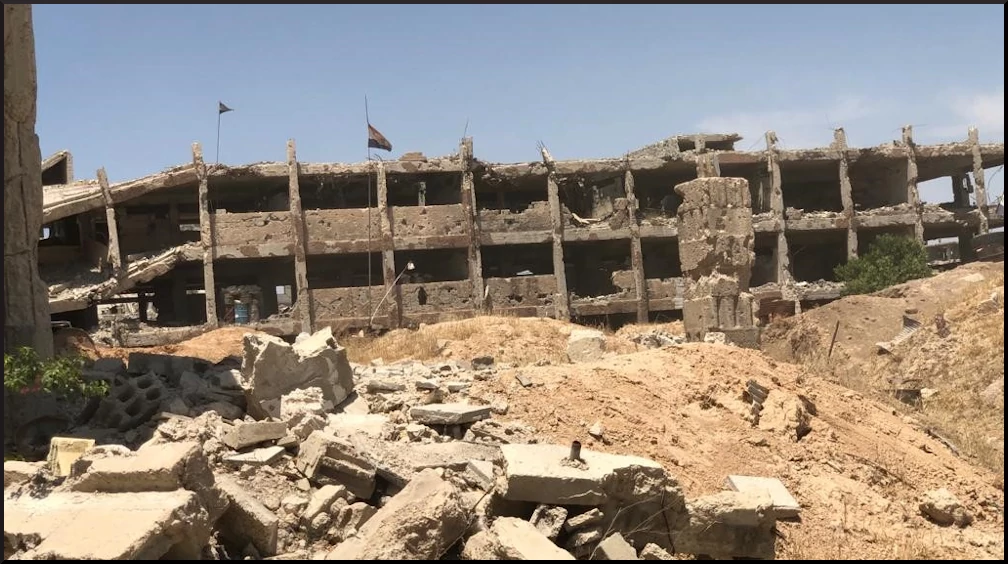
Before the war, Jobar, Eastern Ghouta countryside of Damascus, was the home of about 300,000 people according to the last statistics of 2008. It was considered the economic lifeline of the capital with agriculture, commerce, estates and some industrial facilities. For those who want to enjoy the countryside and fairly cheaper estates but yet close to the capital, Jobar was an attraction location.

In 2013, the Islamist group Faylaq al-Rahman, captured Jobar and dug a network of tunnels in the basement of a school which they converted into a military headquarters, ammunition warehouses and a field hospital equipped with medical equipment, operation rooms, medicine and were used to smuggle food, arms, terrorist recruits and fuel into the area.
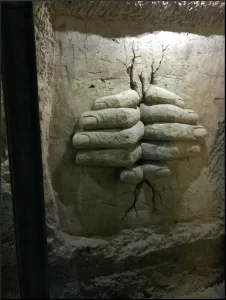
These tunnels were wide enough for a truck to drive through and were dug to control the eastern entrance to the capital. The Faylaq Al-Rahman was able to launch massive mortar attacks at Damascus neighborhoods killing and injuring thousands of people, targeting water pipes, and power grids and causing huge destruction to civilian and government buildings and facilities. The terrorist militias used these tunnels to send suicide bombers and car bombs into the center of the Syrian capital inflecting deaths and injuring innocent people.
Our delegation was escorted by SAA military officers through Jobar tunnels which were one of the largest and longest tunnels dug during the decade-long war. A network of tunnels that stretched 10km long, 15 meters deep, had reinforced walls with metal rods and was equipped with surveillance cameras and lights. After the liberation, these walls were transformed into a museum of sculptures carved in by 18 Syrian artists featuring the sacrifices of the ASA and glorifying the stead-fasting of the Syrian people. These sculptures transformed the tunnels from a death industry yard into a museum of life and love.
Yarmuk Refugee Camp, a Second Nakba
According to old statistics Yarmouk Refugee Camp was the home of 250,000 Palestinian refugees who had seen the camp as their second home. Yarmouk was not a camp like any other refugee camps in the Palestinian occupied territories, Jordan or Lebanon. It is a housing complexes, just like any of the other neighborhoods surrounding the Syrian capital, Damascus, which was provided by the Syrian government for the Palestinian refugees and the United Nations’ Relief and Work Agency (UNRWA) since 1948. The camp was also the home of Syrians from different backgrounds.
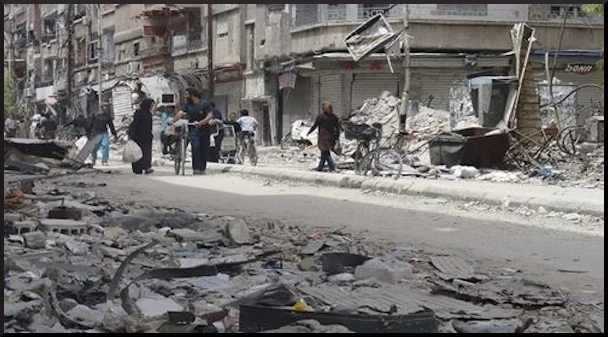
On September 10, 2021, President Bashar Al Assad announced a decree to facilitate the return of Palestinians back into the Yarmouk refugee camp and ordered all related government institutions to cooperate with Palestinian groups and the Embassy of Palestine in Damascus in the efforts for the reconstruction process by cleaning the debris and rubble from the main and branch roads, installing water, power and sewer systems, and to restoring apartment buildings. According to official statistics, 40% of the size of Yarmouk refugee camp is habitable while 40% needs restoration. The remaining 20% is uninhabitable and needs to be totally removed.
During our visit to Yarmouk refugee camp we met and interviewed three people: Abeer, Ali and Mohammad. I will start with the words of Abeer Ali Nayef, a Palestinian refugee from the destroyed village of Ejsem, Haifa, North of Palestine:
AW: How was life like in the camp before 2011? How was the economic condition before the insurgents invaded the camp was?
Abeer Ali Nayef: Yarmouk Camp was a city. We didn’t need anything more than we had. We lived in peace and security. Bashar Al- Assad, the current president, and the late Hafiz Al- Assad, God’s mercy upon him, provided Palestinian refugees with everything they need; free education from kindergarten to higher education, free health care, and job opportunities without any discrimination. We were treated equally as our Syrian brothers, and this is not a compliment, God be my witness. Until many countries such as: Saudi Arabia, the United States of America, Turkey, Qatar and others, mobilized terrorist militants to storm into the camp.
AW: Have you encountered any dangerous situation under the terrorist control?
Abeer Ali Nayef: Yes! They have demolished this wall here while we were sitting in our home and at our watch, they shot missiles indiscriminately. You can tell that they had no military training or education at all, but they carried dangerous weapons such RPG and were shooting left and right at the people, the shops, and the buildings.
Abeer Ali Nayef: They were Tunisian and Chechens, they broke into our house. They were around 20 to 22 Chechens all of them had eyeliner (Kohl) and are on drugs. They also warned us that we must leave the house or otherwise, they will kick us out by force early next morning.
AW: You said that there was a Pharmacy.
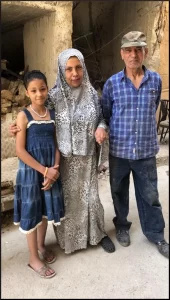
Abeer Ali Nayef: Yes and this building was new and the residents hadn’t come yet. Moreover, the “Free Syrian Army” took control over the Pharmacy and didn’t allow anyone to have access to medications, so they will have more resources to medicate their casualties.
AW: What was the UNRWA’s role in helping the camp?
Abeer Ali Nayef: hey have provided the buses, and from time to time, they provide us with nutritional packages, but I wish if they could provide transportation to make our move easier. There are a lot of people who live inside the camp who come and go on their feet.
AW: What is your message for the world?
Abeer Ali Nayef: I would say for the people who have left since 2018 to return to their homes, both Palestinians and Syrians. We are also annoyed by some people who differentiate between Palestinians and Syrians. We have never noticed any difference among us until these militants broke through. Moreover; at least we live in our homelands with dignity. No one here is telling us to leave and force us to.
AW: What do you think regarding the two-state solution?
Abeer Ali Nayef: There is no state named Israel. It is Palestine and always will be and its capital city Jerusalem.
Moving on to Ali Hamed from Haifa, and for knowing more about trenches, we asked him some questions: why and who build them? Were Palestinians forced to help? How many militants were there that entered and stayed in the Yarmouk camp over six years?
Ali Hamed: Actually, there is no exact number, around one thousand to two thousand, they were from various sides and factions. Such as, Al- Nusra Front, ISIS, and the free military army. And even their commanders vary from different places as Iraq, Jordan and Chechnya.
Ali Hamed: They dug many trenches, let’s say that nearly half of the camp is basically trenches. They used to dig into the street and put soil over it. Then, walk underneath in order to stay invisible. For instance, open like in the middle of the street and dig a trench and then walk through.
Ali Hamed: They also forced Palestinians to work and dig. And when the time comes when they are no longer needed, the kidnappers shot them and throw them out.
Lastly, here is Mohammed Khalid, from Lubia {a Palestinian town located ten Kilometers from Tiberias}. Now, he lives in Yarmook camp since 1948, when they were forced to leave their homes by the Israeli military.
AW: What was the camp like at the beginning?
Mohammed Khalid: Lands and orchids, then the Palestinian Refugee Authority formed a public entity and bought some lands to establish the camp for the Palestinians. Moreover; some of the Palestinians whose conditions were excellent, they all gathered and started building here at the camp. Also, the Palestinian Refuges Authority in collaboration with the Syrian Ministry for Local Administration helped the Palestinians who were willing to build by providing bags for cement, for instance.
AW: What is the scheme for the return of the refugees?
Mohammed Khalid: After the militants left the camp, the government allowed the refugees to return to the camp after they double-checked that there is no current danger. Later, the government announced that the camp is secure and for the people to come back. The people then started submitting applications to check their homes if it has proper conditions to live in or not. That what I have also done myself… I returned to my home for one year and a half.
AW: So, the UNRWA hasn’t had a real impact yet, has it?
Mohammed Khalid: No, UNRWA at this time hasn’t been reached. There was the Syrian Ministry for Local Administration and the Palestinian Refugee Authority.
AW: Does every Palestinian have papers that prove their ownership of where they live?
Mohammed Khalid: No, some have court reports and others have permission from the Refugee Authority as property deeds. For example, this alley here is called the “ Al-Fedayeen” alley where the Palestinians first gathered. Later at that time, the camp has evolved. More people came and bought more and more properties on which they later build and live.
AW: What is your message for the Palestinians?
Mohammed Khalid: I would like to say for them that we are much alike in many aspects. They have our emotions, hearts and souls. Now, we are considered as guests in Syria and we hope to return to our homeland in Palestine when it is free and liberated. I would like to urge them to continue their fight against Israel and to bring back our lost dignity. For them as well to stand by each other, to unify their word. Their conflict is now the Arab conflict not just Palestinian.
AW: You don’t agree on the two-state solution, do you?
Mohammed Khalid: No, because Israel is a state of racism and Zionist. They have a county once in south Russia in Abaijan in 1928. However, Palestine is ours only.
AW: What about the elections that were meant to be held recently?
Mohammed Khalid: The first word is for the nation, first and last, not for the leaders. The resistance is the nation choice. However, the leaders won’t present the 48 nations not even me or the refugees.
Mohammed Khalid: Palestine is one state. There is nothing called two- state solution. As long as there are two states, the conflict will remain and there will always be derogation of the human rights for the misplaced and refugees, who shall return to their lands.
*Photos: All Photos by the Author;
 Syria Support Movement solidarity with the Syrian people
Syria Support Movement solidarity with the Syrian people

